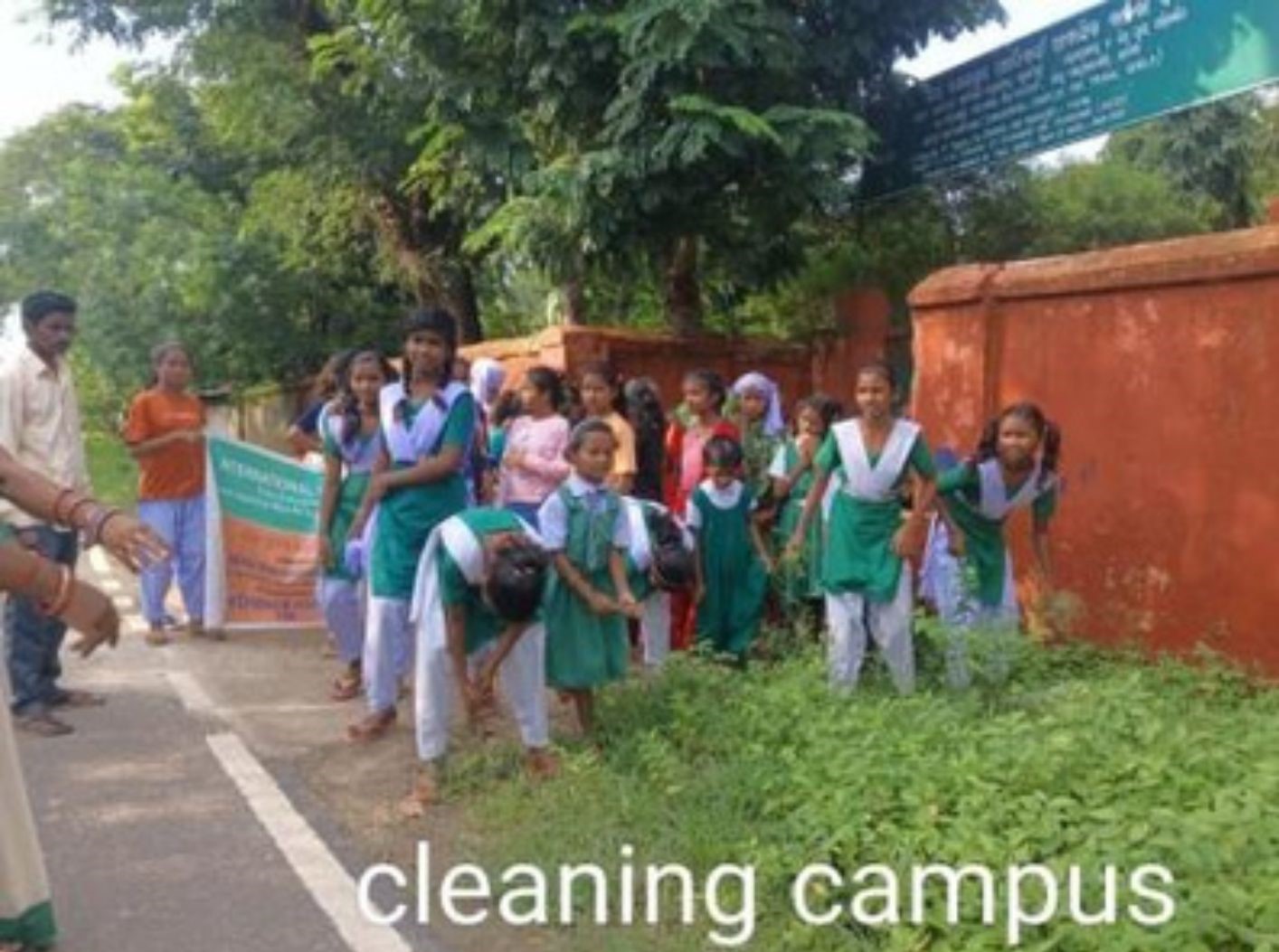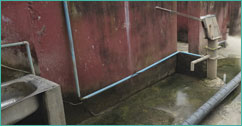SANITATION IMPROVEMENTS AT SEED KAYASHRAM
Swachhata Initiatives
 The school promotes holistic health through various cleanliness and wellness programs. Students practice yoga and different physical exercises, and participate in socially useful productive work (SUPW) which helps promote general health. Students use sanitary latrines, mosquito nets and shoes as mandatory items, and engage in activities like maintaining kitchen gardens in the school premises.
The school promotes holistic health through various cleanliness and wellness programs. Students practice yoga and different physical exercises, and participate in socially useful productive work (SUPW) which helps promote general health. Students use sanitary latrines, mosquito nets and shoes as mandatory items, and engage in activities like maintaining kitchen gardens in the school premises.
The benefits of these practices include:
 Mental peace and improved concentration
Mental peace and improved concentration
 Increased attention span and memory
Increased attention span and memory
 Overall healthier lifestyle
Overall healthier lifestyle
 Clean and green campus environment
Clean and green campus environment
Key Health and Sanitation Programs:
 Regular practice of Yoga, Physical education, and health education
Regular practice of Yoga, Physical education, and health education
 Peer leaders as health educators
Peer leaders as health educators
 Adolescent health education (for personal cleanliness and hygiene)
Adolescent health education (for personal cleanliness and hygiene)
 Linkages with out-of-school children (when girls go home during holidays)
Linkages with out-of-school children (when girls go home during holidays)
 Health cabinets (one student elected as health minister to report illnesses)
Health cabinets (one student elected as health minister to report illnesses)
 First Aid facilities
First Aid facilities
 During the rainy season, the latrine's pit was being filled with rainwater causing spillage of faecal matters inside the toilets. The clay soil in the area makes filtration very quickly which required a new system even when rainfalls are very intense. Since using a soak pit had to result the same problems a new system of horizontal sand filter was used. Finding a location to collect the effluent was very difficult as the outlet of the filter was more than 60 cm deep. A long trench (60 metres) outside the campus was dug to reach an existing trench beside the pond. This was quite complex because a slope was to made to prevent water flow. The horizontal sand filter is made of layer of sand and gravel (around 30 to 35 cm) where filtration occurs and micro-organisms purify the effluent from the twin pits. This kind of construction implies filtrations pipes made from normal pipes which have been partially cut with 5 mm slits, concrete boxes (inlet and outlet), a plastic sheet and geo-textile brought from France to prevent entrance of soil in the filter. Effluent from latrine is therefore partially treated now. This water is suitable for gardening; for this reason a water tank was built with 1-meter-diameter concrete rings. This sand filter also receives liquid from the new urinal which is located near the twin pits. After a period it could be necessary to remove the gravel layer at the entrance of the filter to clean or change it. This aims to allow infiltration rate in the filter to become sufficient again.
During the rainy season, the latrine's pit was being filled with rainwater causing spillage of faecal matters inside the toilets. The clay soil in the area makes filtration very quickly which required a new system even when rainfalls are very intense. Since using a soak pit had to result the same problems a new system of horizontal sand filter was used. Finding a location to collect the effluent was very difficult as the outlet of the filter was more than 60 cm deep. A long trench (60 metres) outside the campus was dug to reach an existing trench beside the pond. This was quite complex because a slope was to made to prevent water flow. The horizontal sand filter is made of layer of sand and gravel (around 30 to 35 cm) where filtration occurs and micro-organisms purify the effluent from the twin pits. This kind of construction implies filtrations pipes made from normal pipes which have been partially cut with 5 mm slits, concrete boxes (inlet and outlet), a plastic sheet and geo-textile brought from France to prevent entrance of soil in the filter. Effluent from latrine is therefore partially treated now. This water is suitable for gardening; for this reason a water tank was built with 1-meter-diameter concrete rings. This sand filter also receives liquid from the new urinal which is located near the twin pits. After a period it could be necessary to remove the gravel layer at the entrance of the filter to clean or change it. This aims to allow infiltration rate in the filter to become sufficient again.
URINALS
Many schoolgirls urinate in open inside school, which is a source of odours and is not hygienically acceptable. As remedy for this issue, two urinals have been constructed. One is located behind the classrooms and the second one is near the latrine and dormitory. To get rid of urine mixed with water, a trench was dug and then filled with gravel and a 6 meters infiltration pipe. It was then laid with geo-textile and covered with soil. With the idea to collect urine for hydroponic agriculture, a system was specially built to collect urine in a jerry-can allowing the non-used urine to be treated in the sand filter.
 Social Education for Environment and Development (SEED)
Social Education for Environment and Development (SEED)




 The school promotes holistic health through various cleanliness and wellness programs. Students practice yoga and different physical exercises, and participate in socially useful productive work (SUPW) which helps promote general health. Students use sanitary latrines, mosquito nets and shoes as mandatory items, and engage in activities like maintaining kitchen gardens in the school premises.
The school promotes holistic health through various cleanliness and wellness programs. Students practice yoga and different physical exercises, and participate in socially useful productive work (SUPW) which helps promote general health. Students use sanitary latrines, mosquito nets and shoes as mandatory items, and engage in activities like maintaining kitchen gardens in the school premises.
 During the rainy season, the latrine's pit was being filled with rainwater causing spillage of faecal matters inside the toilets. The clay soil in the area makes filtration very quickly which required a new system even when rainfalls are very intense. Since using a soak pit had to result the same problems a new system of horizontal sand filter was used. Finding a location to collect the effluent was very difficult as the outlet of the filter was more than 60 cm deep. A long trench (60 metres) outside the campus was dug to reach an existing trench beside the pond. This was quite complex because a slope was to made to prevent water flow. The horizontal sand filter is made of layer of sand and gravel (around 30 to 35 cm) where filtration occurs and micro-organisms purify the effluent from the twin pits. This kind of construction implies filtrations pipes made from normal pipes which have been partially cut with 5 mm slits, concrete boxes (inlet and outlet), a plastic sheet and geo-textile brought from France to prevent entrance of soil in the filter. Effluent from latrine is therefore partially treated now. This water is suitable for gardening; for this reason a water tank was built with 1-meter-diameter concrete rings. This sand filter also receives liquid from the new urinal which is located near the twin pits. After a period it could be necessary to remove the gravel layer at the entrance of the filter to clean or change it. This aims to allow infiltration rate in the filter to become sufficient again.
During the rainy season, the latrine's pit was being filled with rainwater causing spillage of faecal matters inside the toilets. The clay soil in the area makes filtration very quickly which required a new system even when rainfalls are very intense. Since using a soak pit had to result the same problems a new system of horizontal sand filter was used. Finding a location to collect the effluent was very difficult as the outlet of the filter was more than 60 cm deep. A long trench (60 metres) outside the campus was dug to reach an existing trench beside the pond. This was quite complex because a slope was to made to prevent water flow. The horizontal sand filter is made of layer of sand and gravel (around 30 to 35 cm) where filtration occurs and micro-organisms purify the effluent from the twin pits. This kind of construction implies filtrations pipes made from normal pipes which have been partially cut with 5 mm slits, concrete boxes (inlet and outlet), a plastic sheet and geo-textile brought from France to prevent entrance of soil in the filter. Effluent from latrine is therefore partially treated now. This water is suitable for gardening; for this reason a water tank was built with 1-meter-diameter concrete rings. This sand filter also receives liquid from the new urinal which is located near the twin pits. After a period it could be necessary to remove the gravel layer at the entrance of the filter to clean or change it. This aims to allow infiltration rate in the filter to become sufficient again.






